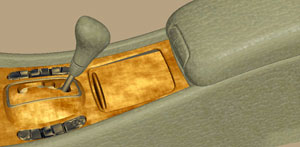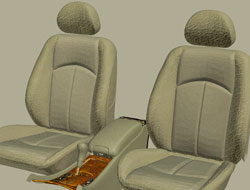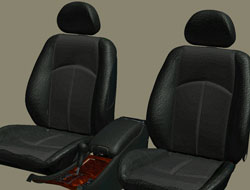
This issue in pdf Subscription Archive: Next issue: October 2005 |
|
|||||||||
Modelling of Authentic Reflectance Behaviour in Virtual Environmentsby Michal Haindl and Jirí Filip Recent advances in computer hardware and virtual modelling allow the view and illumination dependencies of natural surface materials to be respected.The corresponding texture representation in the form of Bidirectional Texture Function (BTF) enables significant improvements in the realism of virtual models, at the expense of an immense increase in material sample data space. Consequently, the introduction of a method for the fast compression, modelling and rendering of BTF data is inevitable. The development of such mathematical models is among the major objectives of the European RealReflect project. The goal of this project is to develop a novel, image-based, physically correct visualization technology for VR-systems. The limited capabilities of current graphics systems restrict the appearance of materials covering virtual objects to low-quality unnatural approximations. The project aims to overcome this restriction by developing a physically correct simulation of light distribution and reflection, as well as an image-based real-time visualization technology for synthetic objects with complex reflectance behaviour. RealReflect –(Real-time visualization of complex reflectance behaviour in virtual prototyping) is a joint research project between the University of Bonn; Vienna Technical University; Max Planck Institute for Computer Science, Saarbrucken; Institute of Information Theory and Automation, Academy of Sciences of the Czech Republic (UTIA), Prague; French National Institute for Research in Computer Science and Control (INRIA), Grenoble; DaimlerChrysler AG, Germany; ICIDO GmbH, Germany; Faurecia, France; and Virtual Reality Architects, Austria. The project is funded by the EU IST-Programme. Several major applications have already come from the project, including realistic virtual models in architecture and the automotive industry; for example, the simulation of safety issues such as blinding of the driver by interior lights in a night-driving situation.
UTIA is responsible for development of mathematical models capable of simulating and compressing BTF textures. Modelling of a natural texture is a very challenging task, due to the unlimited variety of possible surfaces, illumination and viewing conditions along with the strong discriminative functionality of the human visual system. The BTF measurements span the whole hemisphere of possible light and camera positions in observed material sample coordinates, according to selected quantization steps. We used the best recent BTF measurements from our University of Bonn project partners, which contain 6561 images per material sample. In their lossless compressed form, these data require about 5 GB per material sample. Such materials present in a car interior VR scene can easily reach the range of terabytes. UTIA has developed several BTF modelling methods, which can be assorted into three distinct groups: probabilistic models, reflectance models and sampling-based models. As with other texture applications, we have confirmed the experience that there is no ideal BTF model. Models in each group have complementary properties and consequently also optimal application areas.
Our probabilistic models are based either on a set of underlying Markov random fields or probabilistic mixtures, and allow unlimited texture enlargement, BTF texture restoration, huge BTF space compression (up to 1:1000 000) and even modelling of previously unseen BTF data. These methods require neither the storing of original measurements nor any pixel-wise parametric representation. However, such models are non-trivial, and several unsolved theoretical problems exist that must be circumvented. Nonlinear reflectance models offer BTF modelling with excellent visual quality and mild compression ratio (1:200) as well as a fast graphics hardware implementation. Sampling approaches rely on sophisticated sampling from original BTF measurements. They offer high visual quality for most textures, negligible computation complexity but only a moderate compression ratio (1:4). Another drawback of these methods is that unlike our probabilistic models, they do not allow a BTF data space restoration or modelling of unseen (unmeasured) BTF space data. Finally a hybrid method based on Gaussian distribution mixtures was developed with the aim of combining the advantages of both basic texture-modelling approaches. This hybrid model can be used either to directly synthesize textures or to statistically control sampling from the original data. Regardless of single models traits, they all meet comprehensive requirements such as unlimited seamless BTF texture enlargement, high visual quality and compression. In addition, they include some less obvious features like the strict separation of analytical and synthetic parts, possible parallelization or implementation inside a graphics-processing unit. Links: Please contact: |
|||||||||




